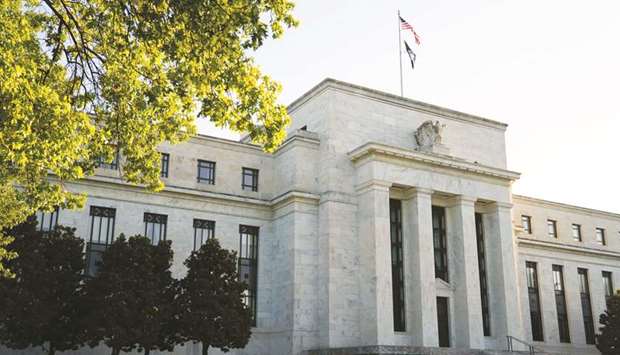The Federal Reserve left interest rates near zero and signalled it would hold them there through at least 2023 to help the US economy recover from the coronavirus pandemic.
The Federal Open Market Committee “expects to maintain an accommodative stance of monetary policy” until it achieves inflation averaging 2% over time and longer-term inflation expectations remain well anchored at 2%, the central bank said in a statement yesterday following a two-day policy meeting.
The statement reflects the central bank’s new long-term policy framework in which officials will allow inflation to overshoot their 2% target after periods of under-performance.
That shift was announced by Powell last month at the central bank’s annual Jackson Hole policy conference.
The vote, in the FOMC’s final scheduled meeting before the US presidential election on November 3, was 8-2.
Dallas Fed President Robert Kaplan dissented, preferring to retain “greater policy rate flexibility,” while Minneapolis Fed President Neel Kashkari dissented in favour of waiting for a rate hike until “core inflation has reached 2% on a sustained basis.”
Chair Jerome Powell was scheduled to hold a press conference at 2:30pm Washington time.
Powell and other Fed officials have stressed in recent weeks that the US recovery is highly dependent on the nation’s ability to better control the coronavirus, and that further fiscal stimulus is likely needed to support jobs and incomes.
The Fed yesterday committed to using its full range of tools to support the economic recovery.
The central bank repeated it will continue buying Treasuries and mortgage-backed securities “at least at the current pace to sustain smooth market functioning.” A separate statement on Wednesday pegged those amounts at $80bn of Treasuries a month and $40bn of mortgage-backed securities.
Officials see rates staying ultra-low through 2023, according to the median projection of their quarterly forecasts, though four officials pencilled in at least one hike in 2023.
In other updates to quarterly forecasts, Fed officials see a shallower economic contraction this year than before, but a slower recovery in the coming years.
In addition to slashing borrowing costs in March, the central bank has pumped trillions of dollars into the financial system through bond purchases and launched a slew of emergency lending facilities to keep businesses afloat.
The economy has partly recovered from the steepest downturn on record and some sectors such as housing are doing well, but Covid-19 continues to kill thousands of Americans each week, unemployment remains high and industries like hospitality and travel are depressed.
Moreover, temporary extra jobless benefits are running out and the political stalemate over a new round of stimulus threatens to set back the economy.
Uncertainty could hang over government policies at least until the outcome of the presidential and congressional elections is clear.
Republicans including President Donald Trump — who trails challenger Joe Biden in national polls — have proposed a smaller package of aid than Democrats have.
The US consumer spending slowed in August, with a key retail sales gauge unexpectedly declining, as extended unemployment benefits were cut for millions of Americans, offering more evidence that the economic recovery from the Covid-19 recession was faltering.
The report from the Commerce Department yesterday could ramp up pressure on the White House and Congress to restart stalled negotiations for another fiscal package. At least 29.6mn people are on unemployment benefits.
Consumer spending accounts for more than two-thirds of the US economy and signs of fatigue grabbed the attention of Federal Reserve officials as they wrapped up their two-day policy meeting.
Retail sales excluding automobiles, gasoline, building materials and food services dipped 0.1% last month after a downwardly revised 0.9% increase in July.
These so-called core retail sales, which correspond most closely with the consumer spending component of gross domestic product, were previously reported to have advanced 1.4% in July.
Economists polled by Reuters had forecast core retail sales rising 0.5% in August. Overall retail sales increased 0.6% in August, in part as higher gasoline prices supported receipts at service stations.
Data for July was revised down to show retail sales increasing 0.9% instead of 1.2% as previously reported.
US stocks were little changed after the data.
The dollar was trading lower against a basket of currencies.
US Treasury prices were higher.
The retail sales report followed data this month suggesting the labour market was losing speed after astounding employment gains in May and June as businesses reopened after being shuttered in mid-March to control the spread of the coronavirus.
Job growth slowed further in August and new applications for unemployment benefits remained perched at extraordinarily high levels in early September.

The Federal Reserve building in Washington, DC. The Federal Open Market Committee u201cexpects to maintain an accommodative stance of monetary policyu201d until it achieves inflation averaging 2% over time and longer-term inflation expectations remain well anchored at 2%, the central bank said in a statement yesterday following a two-day policy meeting.


